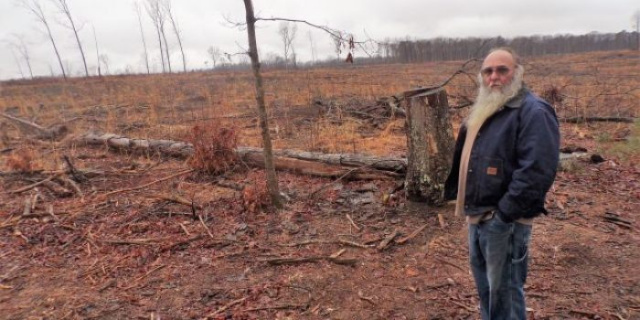|
Spotsylvania
Opponents argue that the project would forever change the character of historic Spotsylvania County, where the Battle of the Wilderness, the Battle of Chancellorsville and the Battle of Spotsylvania Court House took place. “The center of the Civil War is a mile and half from this thing,” said Kevin McCarthy, a 64-year-old retired music director who also lives in Fawn Lake.
They also argue that the county would lose money from lost tax revenue because the solar panel project would lower property values for homeowners — an argument sPower contests. During a driving tour of the area, Sean Fogarty, a 63-year-old retiree with a background in engineering, pointed to a lot purchased by a couple who planned to build a lakeside home not far from the site. Fogarty said the owners have since decided to sell it because of the solar project.
| |
|
SPOTSYLVANIA, Va. – Michael O’Bier has lived here on a hidden piece of land nestled against thousands of acres of trees in rural Virginia for 32 years.
Now, the trees are gone and the 62-year-old O’Bier says he’s packing belongings into cargo trailers. That’s because the site of the largest proposed solar energy project on the East Coast could end up only 62 feet away from the side of his two-story home.
“I would have to leave,” O’Bier told Fox News on a drizzly afternoon this week, looking out over a field of already-cleared trees adjacent to his property. “I can’t live here.”
|
| |
 |
| |
|
“I would have to leave,” resident Michael O’Bier told Fox News, as he stood at the side of his property. “I can’t live here.” (Alex Pappas/Fox News)
WHAT IS THE GREEN NEW DEAL? A LOOK AT THE ECONOMIC AND CLIMATE CONCEPT PUSHED BY PROGRESSIVES
The company sPower wants to build a 500-Megawatt solar project on the 6,350-acre site in western Spotsylvania County, with 3,500 acres being used to house 1.8 million solar panels. The land, currently owned by seven different landowners who plan to sell it to the company, has already been cleared for timber in anticipation of the project. sPower has said the project “will be safe, reliable, quiet and screened from public view.”
But a vocal contingent of activist-residents are working to pressure county officials to deny special use permits for sPower, arguing it would have disastrous environmental, economic and cultural impacts on the area. They point out that the proposed site is nearly half the size of Manhattan.
“Once you let the bulldozers loose, it’s really tough to stop the environmental damage,” said Dave Hammond, a 64-year-old retired chemical engineer who lives in the nearby Fawn Lake community.
|
| |
| Hammond, an active project opponent, said the project would be an “an environmental disaster” for the area. Aside from the thousands of acres of trees that have been cleared, the Concerned Citizens of Spotsylvania group is also worried about water usage at the site, erosion, toxic materials, the potential for fires and the decommissioning of equipment if the project were discontinued. They’re also concerned that the price of electricity for residents could rise because of additional burdens on the conventional grid, though sPower insists it will have no impact on consumer rates. |
| |
|
Opponents argue that the project would forever change the character of historic Spotsylvania County, where the Battle of the Wilderness, the Battle of Chancellorsville and the Battle of Spotsylvania Court House took place. “The center of the Civil War is a mile and half from this thing,” said Kevin McCarthy, a 64-year-old retired music director who also lives in Fawn Lake.
They also argue that the county would lose money from lost tax revenue because the solar panel project would lower property values for homeowners — an argument sPower contests. During a driving tour of the area, Sean Fogarty, a 63-year-old retiree with a background in engineering, pointed to a lot purchased by a couple who planned to build a lakeside home not far from the site. Fogarty said the owners have since decided to sell it because of the solar project.
|
| |
| The Spotsylvania project would be the largest east of the Rocky Mountains and opponents point out that other solar power plants of comparable size are found in sparsely populated areas like deserts. “You’re changing ecosystems forever, and you’re getting closer and closer to people,” Fogarty said of the decision to build in Virginia. |
| |
| |
| |
| |
| |
 |
| |
| SO MANY REASONS WHY SOLAR FARMS DO NOT BELONG ON LONG ISLAND ESPECIALLY THE EAST END! |
| |
| |
|
STOP THE SOLAR FARMS NOW!
VOTE ALL THOSE POLITICIANS
THAT ALLOW THIS TO HAPPEN OUT!
|
SAVE OUR GREEN SPACES!
FOLLOW THE MONEY TRAIL TO SEE WHICH POLITICIANS AND LAWYERS ARE BENEFITTING THE MOST
|
SAVE OUR WILDLIFE AND WATER BASIN!
THESE PEOPLE SHOULD BE HELD ACCOUNTABLE FOR THIS LAND GRAB
|
|
| |
| |
| |
|